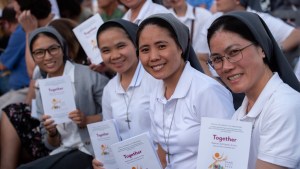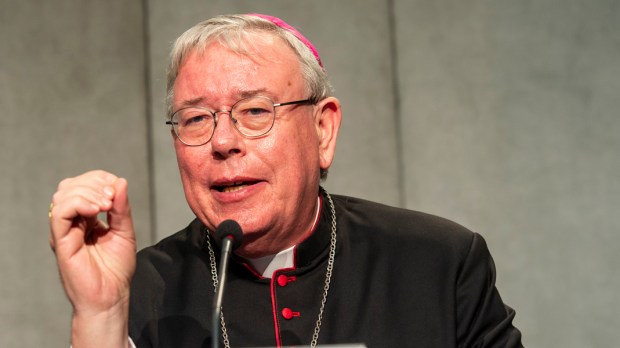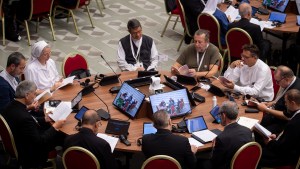On October 18, 2023, Cardinal Jean-Claude Hollerich explained to the Synod members meeting in Rome the “twofold task” they will have to carry out between now and the October 2024 session. First, the members will have to present the “synthesis report” of this month’s work at a local level. Then, they must “plan the collection of reactions” in preparation for the final Roman session of this Synod. The first stages of the Synod began in 2021. The first vote of this Synod, which now includes lay people, approved the principles of this synthesis report almost unanimously in the morning.
Maintaining focus throughout the last module
“We are approaching the end. But beware: This must not become a reason to lessen our commitment to our work, as if it were the last week of school.” These were the words of Cardinal Hollerich, Relator General of the Synod on the Future of the Church, during his introductory remarks to nearly 350 members gathered in the Vatican’s Paul VI Hall.
Since the morning of October 18, they have been tackling the final module — on participation — of the Instrumentum Laboris, the document that summarizes the reflections and questions raised in the Catholic Church over the past two years at local and continental level.
A meaningful hiatus
The cardinal from Luxembourg explained that the proximate end of this Roman session — officially on October 29 — will coincide with the start of an “equally important” phase in the synodal process: the time between the two sessions. In fact, Pope Francis wanted the Synod to take place in two Roman sessions, one year apart. The aim is to allow the reflections — some of which deal with very sensitive issues — to mature in a back-and-forth process between Rome and the local Churches.
Great expectations
Cardinal Hollerich reminded the Synod members that the event is generating high expectations. This is true particularly among the mainstream media, “especially those furthest from the Church” and who are interested in “possible changes on a very limited number of subjects.” But he also spoke of the expectations of committed Christians who are “wondering what will change for them” and how they will experience the “co-responsibility” of all the baptized.
“We are well aware that this Synod will be evaluated on the basis of the perceivable changes that will result from it,” he stressed.
Reactions and dialogue
Speaking in English from his round table set up alongside the 34 others in the vast Paul VI Hall, the Relator General set the course that the members will have to follow once this first session is over. First and foremost, they will have to “return” to the local level “the fruits of our work gathered in the Synthesis Report.” This will involve bishops’ conferences, synodal teams, the media, and the preparation of “paths of experimentation and in-depth study that we will identify together as appropriate,” explained the Archbishop of Luxembourg.
The second task will be to “start planning how to collect the feedback from the local Churches, the fruits of the exchanges and the experimentation and deepening paths.” The aim is “to arrive ‘prepared’ for the second session, that is, loaded with a clearer awareness of the People of God as to what it means to be a synodal Church.”
What will the “synthesis report” look like?
At the close of the morning’s General Congregation, Cardinal Hollerich briefed Synod members on the work of the commission for the synthesis document. The text will be relatively brief, reported Paolo Ruffini, Prefect of the Holy See’s Dicastery for Communication, at a briefing with accredited journalists.
The report will include the points on which the synod fathers and mothers reached consensus, and those on which disagreement remains. This roadmap should present “open questions” that will require further study from a canonical, theological, and pastoral point of view.
This synthesis report is neither a “final document” nor the Instrumentum Laboris for the next assembly in October 2024. “The aim of this document will be to accompany the next phase,” emphasized Paolo Ruffini. He added that the commission would also like to write a letter to tell all Christians about the experience of the Synod members during this month.
In agreement with the Pope, the proposal was put to the vote of the assembly, which adopted it by a very large majority: 335 votes in favor to 11 against out of 346 votes cast. This was the first time that the assembly had voted, and thus the first time that 45 lay people could exercise their right to vote within the Synod of Bishops, an institution created after the Second Vatican Council and originally composed only of bishops.
Synod members now work on participation
In the morning, the Synod members inaugurated a cycle of reflection on “participation.” This is a crucial theme since it involves tackling the very concept of authority in the Catholic Church, and the proper articulation of powers within it. The cardinal explained that it was not intended to “question the authority of ordained ministers and pastors,” but of understanding how lay people could also participate in the Church’s mission and be “co-responsible” for it, by virtue of their baptism.
Fighting clericalism
On the subject of clericalism, which refers to the abuse of power by members of the clergy and which Pope Francis wants to eradicate, Cardinal Hollerich offered a warning. “Where clericalism reigns, there is a Church that does not move, a Church without mission.” Echoing frequent messages of the Argentine pope, he stressed that clericalism can also impact the laity, “when [clergy] claim to be in charge forever.”
This Synod must fight against all forms of clericalism, and therefore move the lines. For clericalists “only want to maintain the ‘status quo,'” he said — a status quo that “cements their power.”
Many questions to address
In the section of the Instrumentum Laboris devoted to participation, there are some 60 widely varied questions that Synod members must now address. In particular, the document asks how to encourage the participation of women, young people, and minorities in the Church. It also raises the question of how to adapt ecclesial structures to a synodal style of governance.
It further provides food for thought on the degree of doctrinal authority of episcopal conferences, and on the right attitude of the pope in cases where local authorities take different directions.



